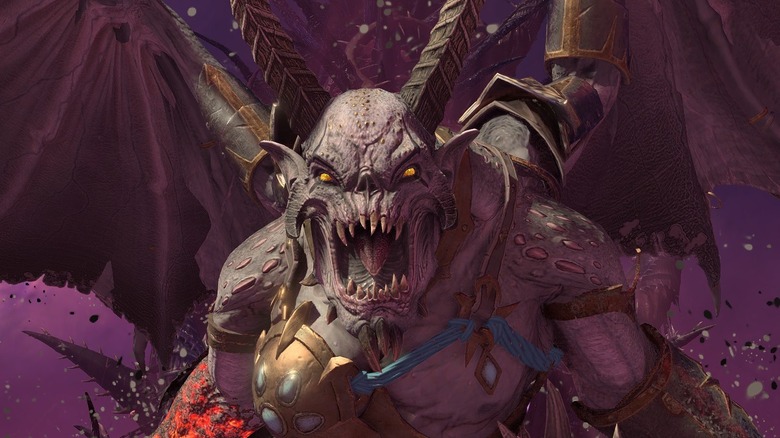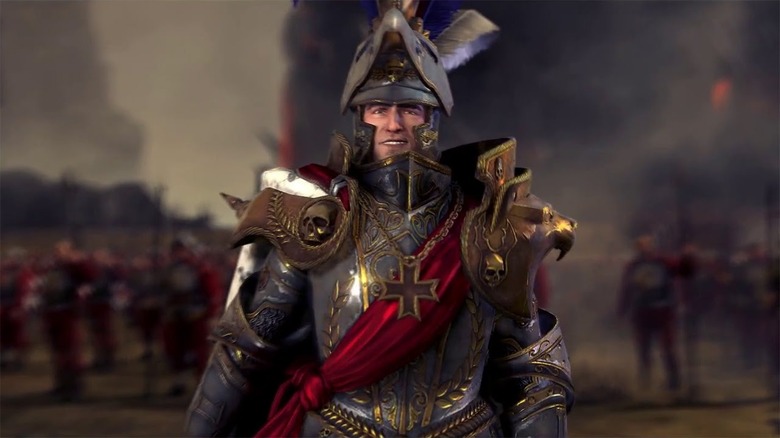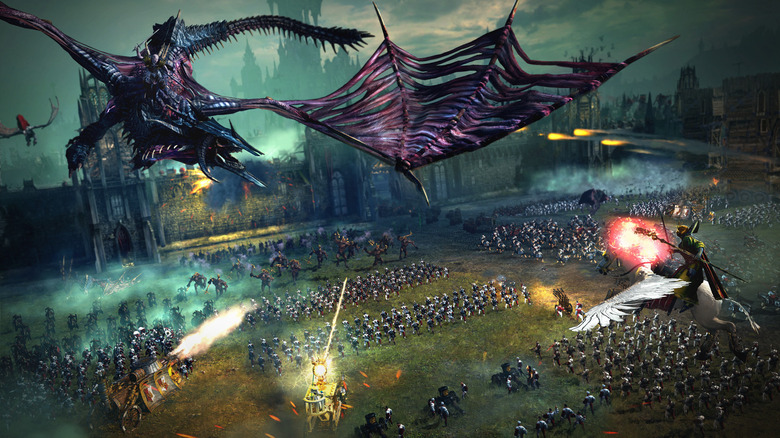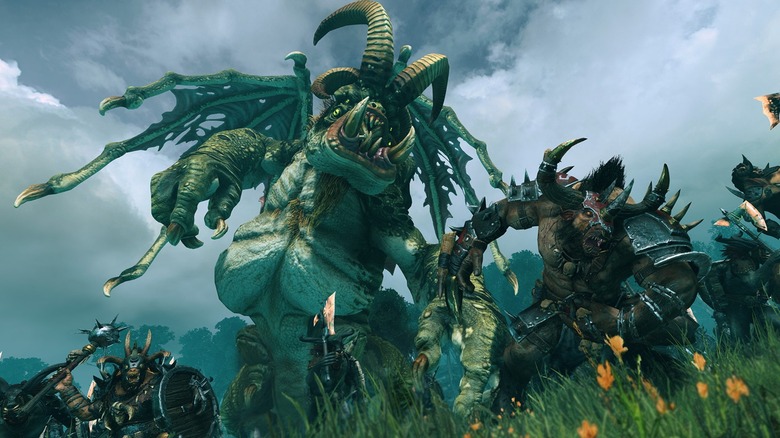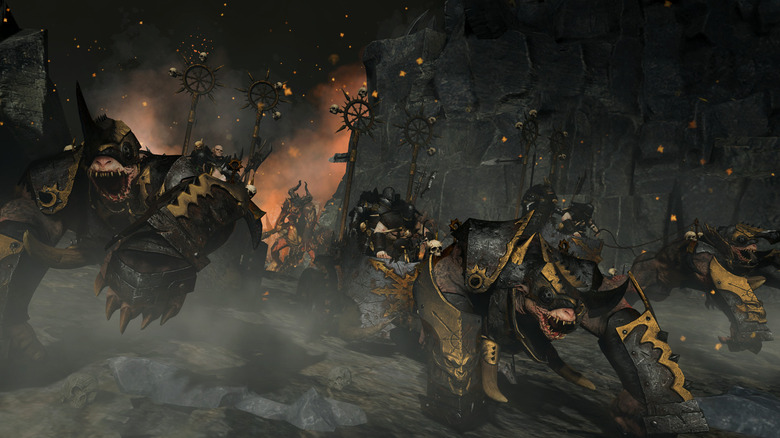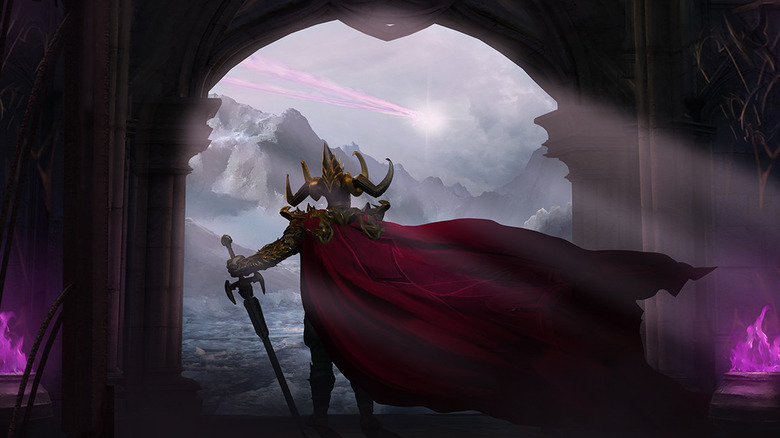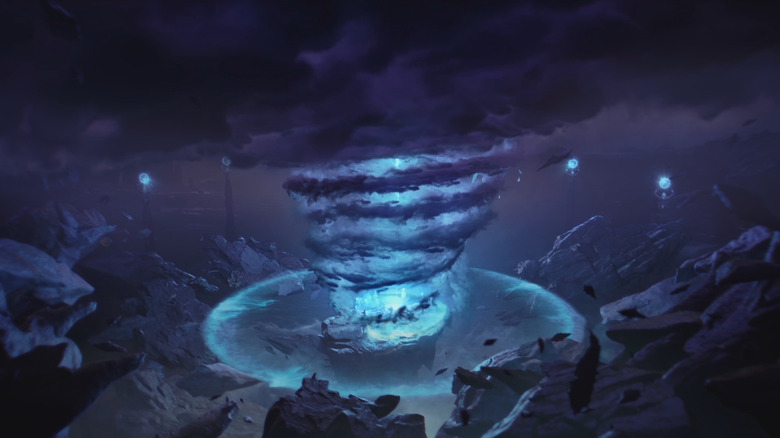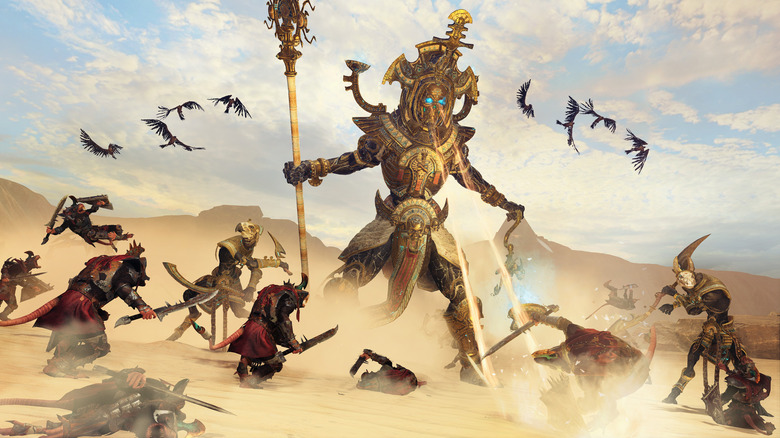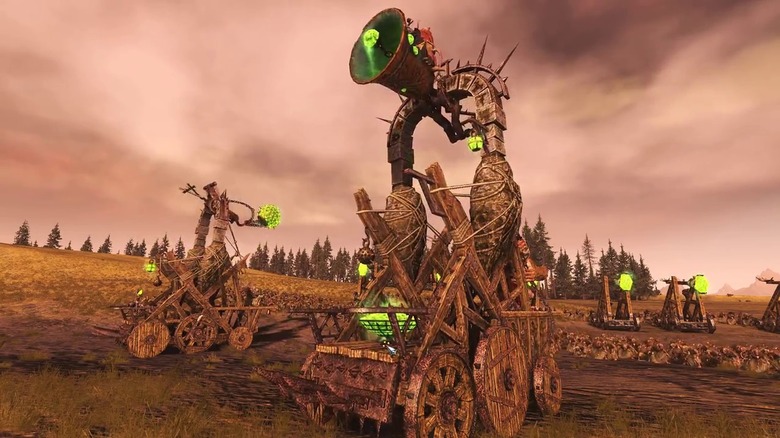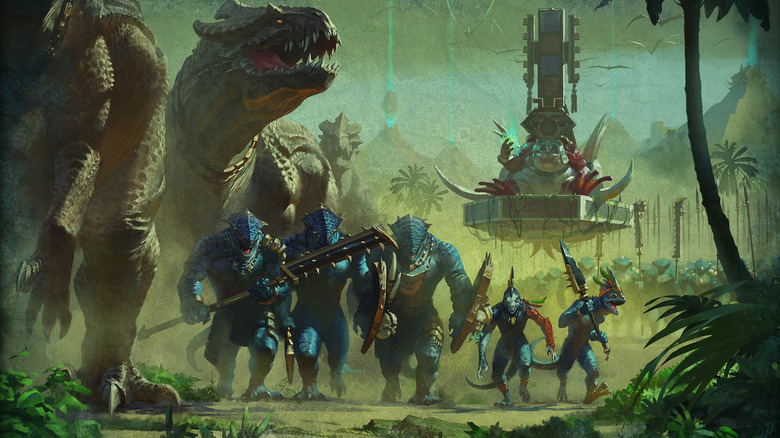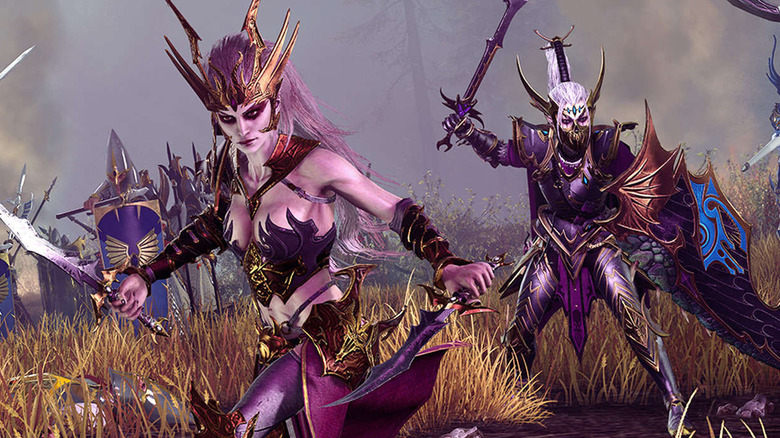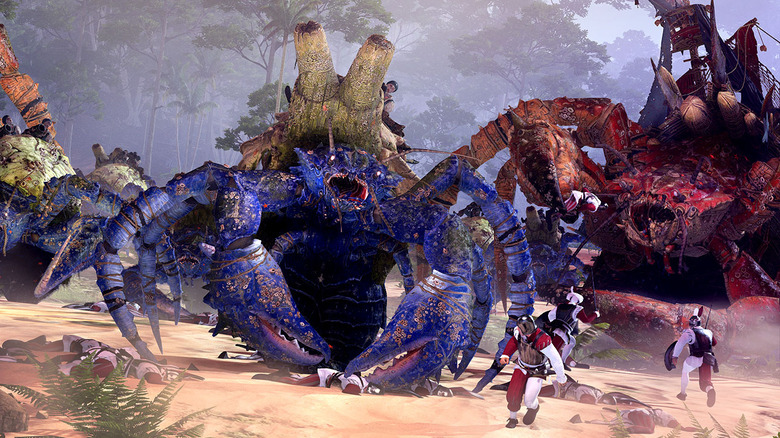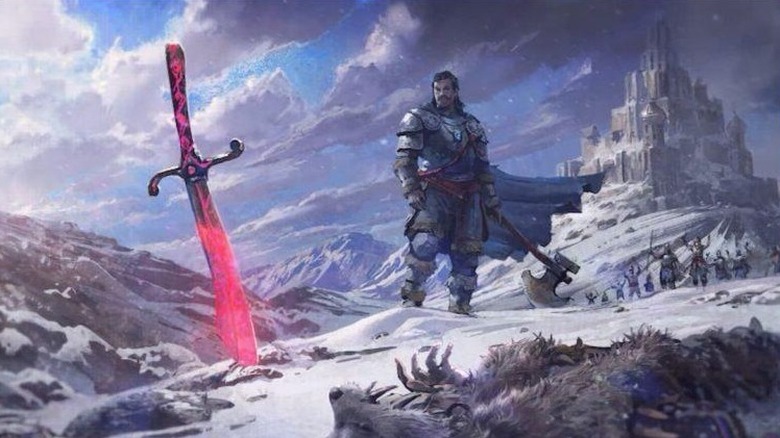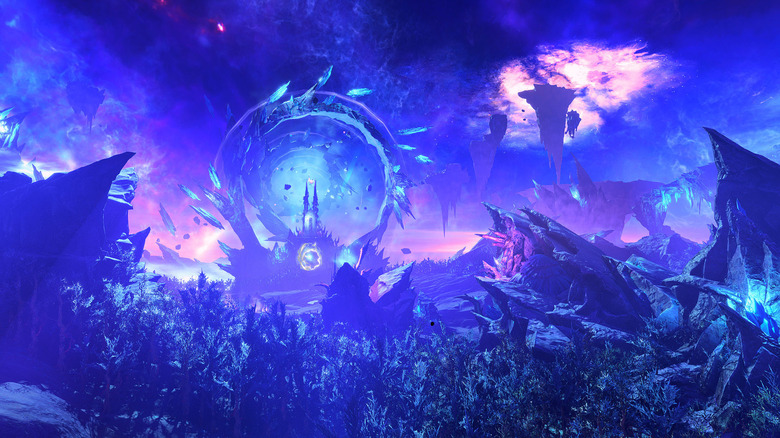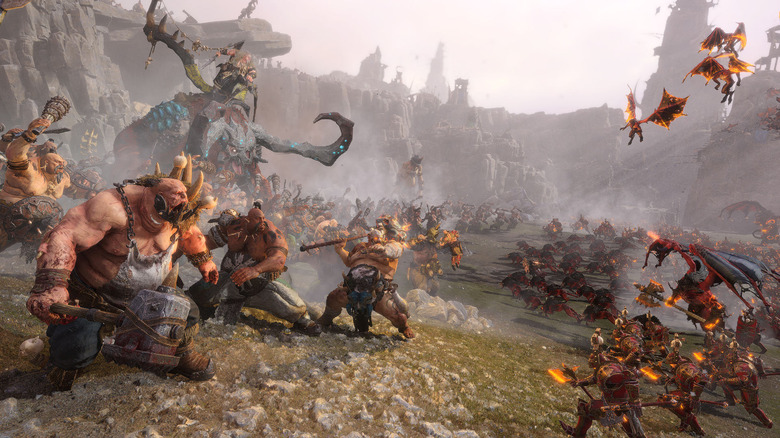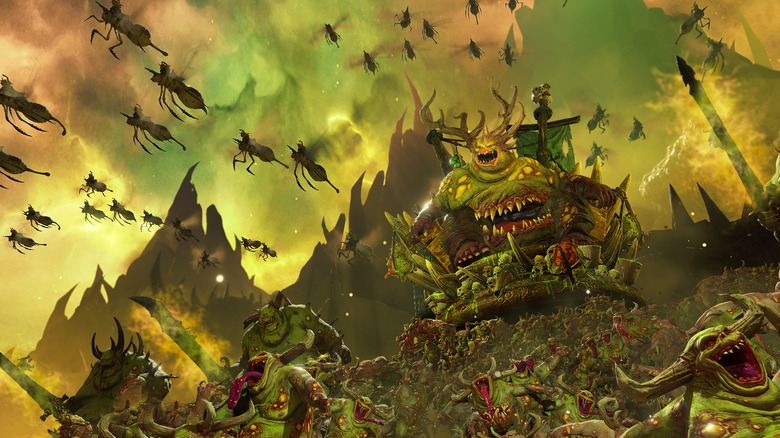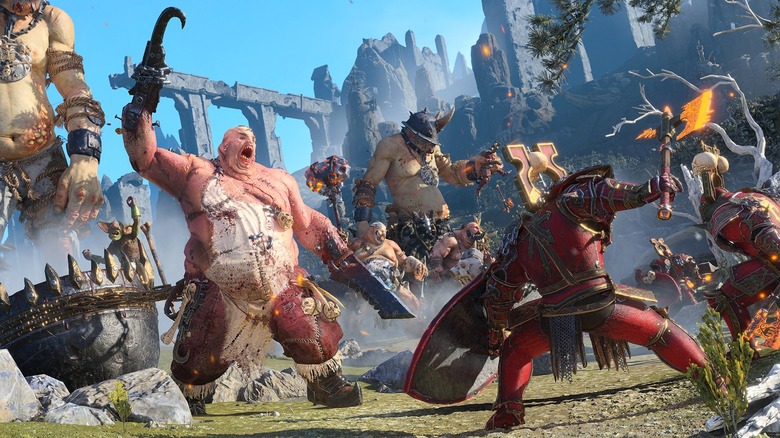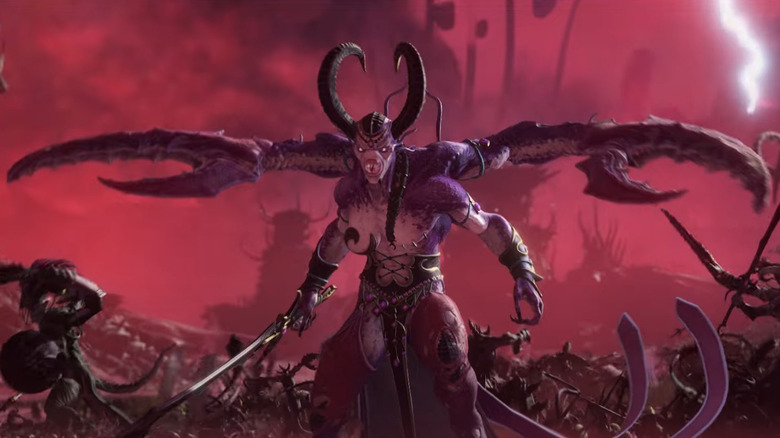The Entire Total War: Warhammer Timeline Explained
The "Warhammer" universe is one of the most detailed and lore-filled in fantasy, covering thousands of years of history and filled with wars and conflicts between multiple dimensions of races, gods and creatures. "Warhammer" spans dozens of books, countless video games, tabletop games, and entire websites dedicated to parsing through the intricate layers of its factions, characters, and geopolitical events. One of the most successful video game series derived from the property has been Creative Assembly's "Total War: Warhammer."
The "Total War" series has long been one of the most sprawling and tactically-minded strategy brands on PC. The series has historically focused on realism and placing players in control of real-world factions and situations that blend turn-based macro decisions with massive real-time battles. This makes the series a perfect framework for the deep world and gameplay roots of "Warhammer Fantasy." The sub-series has been praised by critics for its ability to highlight the unique aspects of every race and culture in the universe and incorporate those elements into each gamer's distinct playstyle.
However, the depth of the setting can be a bit hard to parse through, even for hardcore fans of the series, especially since the games split up their stories into multiple lengthy campaigns. Not only that, but many of the endings are dependent on the faction picked by the player. But now with the final entry in the trilogy released, it's time to take a look at the entire timeline of "Total War: Warhammer."
Karl Franz and the Dwarves
The trilogy's story starts in the first "Total War: Warhammer," in which Karl Franz is elected to take the imperial throne in 2502 IC. Although Franz was rightfully elected to his station, not all nobles of the empire are in favor of his rule, leading to the rise of a resistance movement that threatens to throw the empire into civil war. Franz is also tasked with extending the control and influence of the empire to bring peace to the Old World. This puts him in a precarious position extremely early in his rule, tasking players with trying to make the most of a shaky situation.
Meanwhile, the Dwarven clans near him are also resisting the continental peace that Franz hopes to build. The clan of Karaz-a-Karak is led by Thorgrim Grudgebearer, who is intent on going to war with the nearby Greenskin orc tribes. Thorgrim even keeps a "Book of Grudges" that tracks every insult his clan takes from the Greenskins, just so that they can know they're paid back in full. If he fails to do so, his rule be called into question and his power will begin to wane, especially as the Greenskins continue to take up residence in conquered Dwarven keeps.
The Greenskins and Vampire Counts
Those same Greenskins are also intent on war. Grimgor Ironhide's Vagabond tribe is led by Orcs, but also includes other races. Grimgor is more ambitious than most of his peers and has aims see the Greenskins rise to be one of the most powerful orc tribes in history. To do so, he begins raising an army to march south and conquer the tribes of the Black Crags and the Badlands. Then, with his massive army complete, he will march on the civilized peoples of the Old World and crush their insulting cities and structures to the dust.
In the more distant land of Sylvania, however, the terrifying ruling body of Vampire Counts have started organizing to claim the empire throne for themselves. The vampire Von Carstein has begun building this army slowly through the use of dark arts and necromancy. It does not take long for him to build a terrifying undead force. This army is incredibly persistent and obedient, not to mention willing to throw themselves wherever their master commands them without pause until they are all completely destroyed. This makes Von Carstein one of the most significant threats to the empire, one that could spell an early end to Karl Franz's nascent reign.
The Beastmen and the Wood Elves
The two DLC campaigns that occur at the same time as the main story feature the Beastmen and Wood Elves on separate maps. The Beastmen campaign follows the Warherd, led by Khazrak the One-Eye. Khazrak stands out amongst other Beastmen because of his strategic mind, which is more than supported by his bestial savageness and cunning. However, Khazrak is not interested in the squabbles and politics of the Old World and instead embarks on a quest to find revenge against his oldest foe, Boris Todbringer.
The Wood Elf campaign is set in the mystical forest of Athel Loren, a dense land of living trees and plants that constantly groan as they shift and adjust to create new paths and walls. The Wood Elves live in the towering Oak of Ages, where they work to expand and grow their kingdom further. This storyline sees the Wood Elves launching a daring campaign to conquer more of Athel Loren, even as they struggle to maintain their more distant borders.
Chaos in the North
The existential threat that ties the struggles of all these factions together are the forces of Chaos building in the northernmost region of the Old World. These adversarial forces are led by Archaon, a former priest of the god Sigmar who was corrupted by Chaos. His thirst for power has led him to conquer all of the Chaos Wastes, a ravaged wasteland dominated by the plague of Chaos. Archaon begins mobilizing his armies, their steps sounding like thunder as they march across the rocky terrain.
His goal is to start the End Times, a foretold apocalypse that would see the Old World falling to the forces of Chaos. Archaon's forces are a threat to all mortal life on the continent and can only be beaten by a great hero. No matter what faction achieves their goals in the main campaign, they all have to contend with the terrible threat of Chaos looming just beyond the horizon. Thankfully, the force is ultimately defeated, although the identity of the foretold hero depends on which faction the player picks.
The Twin-Tailed Comet
"Total War: Warhammer 2" evolved the campaign of the first title by featuring a core story that seamlessly weaves its individual campaigns together. The campaign begins with a twin-tailed comet being spotted arcing across the sky, which is seen as an omen, foretelling both amazing and terrible events alike. Many see it as a sign of the growing power of the forces of Chaos, but it also signals the rise of great heroes who will be able to fight those forces.
However, the passing of this particular comet also causes a disruption in the Great Vortex, a powerful maelstrom of magic that was created by the High Elves in the year -4421 IC. The Great Vortex was originally constructed and used to banish the Daemons of Chaos from the mortal plane, but the passing of the comet alters the Vortex, leaving the mortal plane extremely vulnerable and offering an incredible amount of power to any who can claim it.
The Race for the Great Vortex
The vulnerability of the Great Vortex sparks a race to claim its power by the races of the Lizardmen, High Elves, Skaven, and Dark Elves. The High Elves who originally created the Great Vortex want to protect it from being manipulated and taken by the other races, all while stabilizing its existence and keeping the daemons of Chaos from the mortal realm. The Lizardmen have similar motivations: While they do not already have a relationship with the Great Vortex, they care deeply about maintaining its protection of the plane and set out to help protect it — with or without the help of the High Elves.
The Skaven and Dark Elves, however, have much more sinister motivations. Instead of trying to protect the Great Vortex, these two factions hope to take the power contained within the Great Vortex for themselves, regardless of the wider consequences for the world. Both forces have long-held desires to conquer the world for themselves, so it's up to the player whether the world is thrown into Chaos or ruled with an iron fist.
The Black Pyramid of the Nagash
Outside of the battle for the Great Vortex, a desert-based undead race known as the Tomb Kings were also impacted by the passing of the two-tail comet. The comet activated a colossal structure known as the Black Pyramid of Nagash, which was originally built by the necromancer Nagash, bankrupting his empire in the process.
This pyramid was an extremely powerful structure that towered over the surrounding land. Its foundation is filled with the corpses of fallen servants, while the walls contain powerful wards and ritual runes etched into them.
In fact, the Black Pyramid is so powerful that after his initial defeat, Nagash used it to kill all life in the region before he would let another rule in his place. Once the twin-tailed comet activates the pyramid, however, the Tomb Kings learn they must collect five magic books to fully understand the building's power and how to control. And so, they launch a campaign to track down the books and claim the power of the pyramid for themselves, which will allow them to consolidate their power and start conquering the land.
The Skaven Deception and Vampire Pirates
As the Tomb Kings near activating their pyramid — and the other races near completing the rituals required to claim the Great Vortex — it is revealed that the twin-tailed comet was a fake. In fact, it was not a comet at all, but a rocket built and launched by the Skaven to deceive the other races.
The Skaven did this to fabricate the race for the Great Vortex in its entirety, tricking the other races into sending the combined power of their rituals into a massive Skaven Bell. Once there is enough magic in the bell, it can be used to raise their great deity, The Horned Rat.
It is at this point in the campaign that the game's DLC campaign, "Curse of the Vampire Coast," is set. This campaign follows a faction of vampire pirates (who are as awesome as they sounf). The vampire pirates, noticing how distracted the other races are by the rush for the Great Vortex, seize the opportunity to comb the seas for a great relic known as the Star-Metal Harpoon.
The Harpoon is renowned to be so powerful that the vampires believe it can be used to track down and slay the greatest of the Merwyrm, a sea-bound cousin of dragons. This quest sets up the ultimate web of conflicts that leads to a different ending for the game for each faction.
High Elf or Lizardmen Victory
If you decide to play as the High Elves, "Total War: Warhammer 2" will end with them taking control of the Great Vortex again. Once they do, they are able to stabilize it and re-dedicate themselves to defending its existence and keeping the daemons of Chaos from entering the mortal plane. This ending also keeps the political balance of power across the continent intact, as it prevents any of the other forces from growing in power and using it to conquer their foes or sow destruction.
If Lizardmen gain control of the Great Vortex, however, they also stabilize it — but are not so benevolent afterwards. Instead, they decide that their victory is a sign from the Old Gods that they have been chosen to enact the Old Gods' will across the continent. The Lizardmen quickly launch a crusade to wipe out any and all forces or people they see as unnatural or unintended for the world.
Dark Elf or Skaven Victory
The outcome of "Total War: Warhammer 2" is much more grim if the machinations of the Skaven or Dark Elves win the day. If the rat-like Skaven are successful in their campaign, they gain enough power to summon The Horned Rat after taking the power of the Great Vortex for themselves. With the coming of The Horned Rat, the Skaven set out to conquer the world for themselves, bringing about The End Times — which is notably depicted in the "Vermintide" series.
If the Dark Elves are the ones who claim the Great Vortex, they manage to be even more selfish with its power. After banishing The Horned Rat and killing the Skaven, the Dark Elf leader Malekith absorbs its power into himself. Of course, this makes the Dark Elves into an extremely powerful and formidable force in the world, but it also allows Malekith himself to ascend to godhood, gaining immortality and ever-growing influence over the world of "Warhammer."
Tomb King or Vampire Coast Victory
Outside of the Great Vortex campaigns, the Tomb Kings and Vampire Coast Pirates can achieve their own great victories. In the case of the Tomb Kings, they manage to collect the five books to activate the Black Pyramid of Nagash. Using it to manipulate the winds of magic, the Tomb Kings are able to reclaim their old empire and begin conquering new lands. The undead army is able to kill all that stand in their way, slaying their enemies and raising them again as new additions to their forces.
The Vampire Coast Pirates are eventually able to get their hands on the Star-Metal Harpoon and use it to do battle with the great Myrmidon. The pirates are eventually able to defeat the Myrmidon by unlocking the harpoon's power with the hidden magic of ancient sea shanties. But they don't stop there. Next, they use the Harpoon's power to also raise the Myrmidon in an undead form that they are able to control, becoming the most feared and storied pirates ever known.
The Birth of a New Daemon Prince
The story of "Total War: Warhammer 3" begins with a prologue introducing the land of Kislev, which has fallen into a seemingly eternal winter.
This winter has thus far lasted for seven years after the bear god Ursun has mysteriously failed to lift the season as it always used to. The people of Kislev grow desperate and send the brothers Yuri and Gerik Barkov on an adventure to find Ursun and help him if he requires it. The brothers are guided by the voice of Ursun, who tells them that he has been taken prisoner by the first Daemon Prince Be'lakor.
However, it is actually Be'lakor speaking to the brothers, slowly corrupting them with the influence of Chaos. Be'lakor drives Yuri to kill Gerik to make a bridge of bones to reach Ursun, where Be'lakor's role in his journey is revealed. Rather than lashing out at Be'lakor, Yuri is influenced further to try and kill Ursun and claim his power for himself. Yuri shoots Ursun in the heart, but is ultimately unable to kill him and almost dies in the process. For his dedication, however, Be'lakor infuses Yuri with Chaos, making him a new Daemon Prince.
The War for Ursun
Be'lakor then takes Ursun to the mystical Forge of Souls and imprisons him there, intent on using him to take revenge on the Chaos Gods he feels betrayed him. However, Ursun's mighty roar is able to tear the fabric between the realms of Chaos and mortals. This creates a storm that strands the daemons of Chaos in the mortal realm and alerts the mortal factions of Ursun's imprisonment, ultimately laying the groundwork for the campaign of "Total War: Warhammer 3."
With the mortal races and forces of Chaos both aware of Ursun's weakened state, the two sides assemble their armies to march on the Forge of Souls. The ultimate goal for doing so varies from race to race, with the mortals largely hoping to save Ursun and the forces of Chaos seeking to kill him for their own benefit. This leads to the biggest conflict the series has ever seen as mortals and demons go to war once more.
The Mortal Races
Of the mortal factions fighting for Ursun, there is the land of Kislev, the empire of Grand Cathay, and the Ogre Kingdoms. Kislev has the purest of intentions and hope to heal Ursun so that he can end their eternal winter and save the land. The people of Kislev also hope to redeem themselves after discovering that their own hero, Yuri, fell and was corrupted by Chaos.
The human empire of Grand Cathay wants to free Ursun for its own purposes. They worship a group of dragon deities, and hope that Ursun can help them find the lost dragon Shen-Zoo. The people of Grand Cathay are also motivated by the desire to stop the forces of Chaos from carrying out any of their disastrous machinations. The Ogre Kingdom are much less benevolent, desiring to capture Ursun while he is weak so that they can eat him and grow more powerful. They plan to use the remains of this great feast to feed to their own god, The Great Maw, to gain his favor.
The Forces of Chaos
Ursun is also greatly desired by worshippers of the different Chaos Lords, including Yuri's new faction of Daemons. One of the most fearsome of these is a group of Khorne worshippers led by a warrior named Skarbrand, who aims to kill Ursun himself and claim his skull in the name of his Blood God. Then there are the Oracles of Tzeentch, who are led by Kairos Fateweaver. Kairos wants to steal Ursun's eyes and use them to see all of time.
Next, there are the forces of the God of Disease, Nurgle. Led by Ku'gath Plaguefather, this sect of cultists and daemons want to capture Ursun to use his corpse for numerous experiments, all with the goal of developing a new plague that can kill even gods. Meanwhile, the God of Hedonism, Slaanesh, also has a devoted group of followers led by N'Kari who want to claim Ursun. However, Slaanesh wants to keep Ursun alive in captivity to torture him for eternity.
Finally, there is Yuri's mixed group of daemon forces. Yuri wants to complete his task of killing Ursun, not only to redeem his previous failure, but to absorb the god's power for himself and destroy the land of Kislev, which Yuri sees as having abandoned him.
Mortal Race Victories
If players choose to run through the campaign as the forces of Kislev, they will ultimately face and have to defeat Be'lakor. However, when they reach the Forge of Souls, they'll discover that Ursun has been killed, and only his massive corpse remains. Thankfully, he is revived by the faith of his dedicated followers.
Some "Total War" fans have voiced their disappointment of the ending of the Grand Cathay campaign, however. In this version of events, Ursun is still killed, but the winning forces can commune with his spirit to learn the location of Shen Zoo. Meanwhile, Be'lakor is forced to become the empire's servant by Tzeentch. Some players feel like the inevitable death of Ursun limits the narrative in some ways.
If ithe Ogre Kingdoms are able to defeat Be'lakor and take the Forge of Souls, they achieve their dream of eating the god's corpse. This allows them to grow more powerful, and they feed what is left afterward to The Great Maw to gain his favor. These events give them the power to go out and destroy even more civilizations — and find more meat to eat.
Forces of Chaos Victories
If Khorne's worshippers are victorious in the campaign, Skarbrand plunders Ursun's skull from his corpse to offer to the Blood God. However, what many see as the ultimate offering for the Skull Throne is not enough, and the only response Skarbrand receives is Khorne's laughter. If Kairos Fateweaver is successful in plundering the body of Ursun, their victory is much more beneficial. With Ursun's eyes at their disposal, they become the new master of time.
If the worshippers of Nurgle are able to get their conniving hands on Ursun, they use his corpse to begin concocting terrifyingly powerful new diseases. If the player leads the forces of Slaneesh to victory, they are not able to capture Ursun for eternal torture (as he is already dead in this ending, as well). However, Slaneesh does still take joy in the continued suffering of the people of Kislev, trapped in their eternal winter. If Yuri is able to defeat Be'lakor, he is able to become even more powerful. Now dubbed the "God Killer," Yuri launches a horrifying campaign to destroy all of Kislev.

